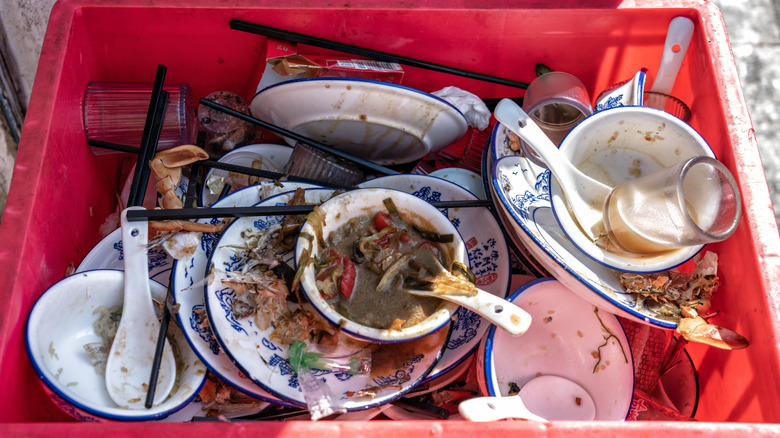This Country Wastes 4 Times More Food Than The US Annually
We all know that food is precious, yet somehow, more of it gets chucked in trash bins worldwide than you think. A big portion of the wastage oozes out of the U.S., and not just at a commercial level — consumers are as guilty as producers of turning good food into trash. Yet one country tops the U.S. in food waste by a wide margin — not because its citizens are extra wasteful, but because there are so many of them. That country is China, and this is how it got the title of the world's most food-wasting nation.
China is a mega-producer that discards over 108 million tons of food each year, according to data compiled by the World Population Review. That's more than four times than the U.S., which wastes a total of over 24 million tons annually. Broken down, that's about 76 kilograms of wasted food per person annually in China, versus approximately 71 kilograms per person in the U.S. — so on a per-person basis, they're roughly even. China, being home to the world's largest population, turns that similarity into a staggering imbalance.
What's behind China's colossal waste pile? In big cities, food waste alone was estimated at well over 19 million tons annually, a monumental weight that could feed 30 to 50 million people. Urban restaurants and canteens serving lunch to local workers are responsible for a whopping 90% of China's consumer-stage waste. To combat this, China launched the Clean Your Plate Campaign in 2013, re-ignited it in 2020, and even passed anti-food-waste laws — all to discourage overeating, binge-ordering, and showy banquet culture. While some efforts dropped off after initial enthusiasm, stronger policy and appeals to food security gave the campaign a second wind and legal backing.
What is 'food waste' exactly?
Food waste is far beyond throwing out banana peels or that dry, stale bread. The United Nations-aligned definition pinpoints it as any edible food that's discarded at the retail or consumer level — even though it could've been eaten. That includes perfectly good leftovers, produce tossed after the often-misinterpreted "best-by" date, or food rejected for looking "too weird" for supermarket shelves.
The food waste story is more tragic comedy than horror film. Estimates suggest that up to 40% of all food produced is wasted — somewhere around 1.3 billion tons per year. In U.S. households, about 43% of waste happens at home, where the average family of four dumps roughly $1,600 in edible produce annually. From overbuying and label misinterpretation to serving sizes that laugh in the face of moderation — it's a buffet of avoidable errors!
Beyond national pride or fertilizer potential, the stakes are global. Food loss and waste are not just wallet-burners — they gobble up roughly 8 to 10% of global greenhouse gas emissions, because rotting food in landfills releases methane, a greenhouse gas far more potent than carbon dioxide. And if we could redirect just a fraction of what's wasted, we could feed more than a billion people annually. China's challenge isn't unique — but its sheer scale makes it a poster child for why practicing small habits to reduce food waste, and policy changes can add up to huge planetary wins.

